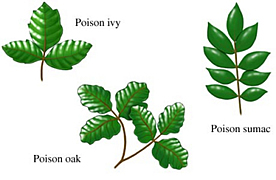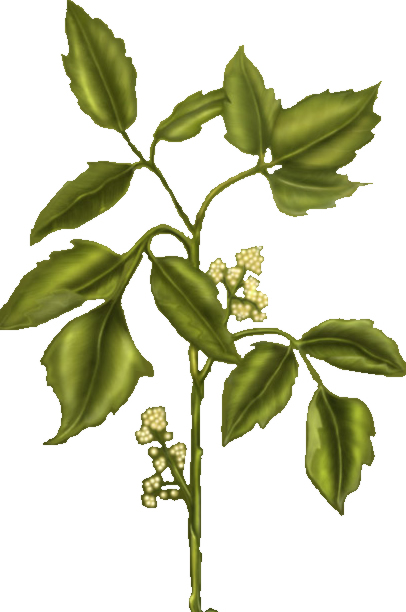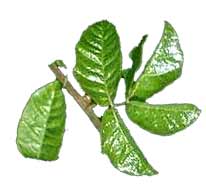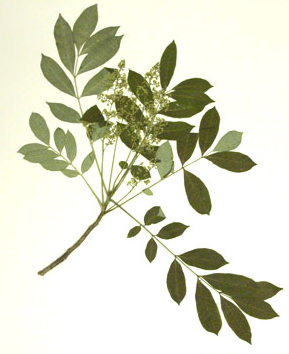|
|
|
SAFETY TIP 7
NATURE’S SAFETY HAZARDS
<< return to previous page
Part 1 – Poisonous Plants
Leaves of Three, Let It Be!
This is the first of a Spring & Summer Series of “Safety Tips” featuring nature’s hazards in the field.
When we were youngsters, many of us learned how to recognize and avoid poisonous plants such as the “terrible trio” of poison ivy, poison oak, and poison sumac, by the simple little refrain “leaves of three, let it be.”
“The Terrible Trio”
Recognition – Learning how to recognize these poisonous plants, and taking some simple precautions is the best way to avoid contact and the possibility of an irritating (and sometimes painful) post-exposure reaction.
Poison Ivy – This is probably the most prevalent and troublesome of the three-leaved poisonous plants within North America. It seems to become more profuse every year, and although many people consider it to pose a hazard just in the wild or “backwoods”, it may be just as prevalent in your yard or garden, or even intermingled among your shrubs. It can also be found along the side of roadways, on pond and lakeshores, riverbanks, and vacant lots. It grows best in fertile well-drained soil, but can also be found in dry locations, sandy, rocky or loamy soil, and in both sunny and shady locations. Poison ivy can usually be found as a vine-like ground cover, or climbing fences, trees, and even around and up utility poles. Sometimes this plant is found in a small bush-like shape. In other words, poison ivy can be found just about anywhere. It is considered by most dermatological experts to cause one of the most common and bothersome skin reactions (contact dermatitis) in North America. In fact, some studies show that one out of every t wo people will be adversely affected by poison ivy exposure in their lifetime. While exposure usually results in a rash and itchiness of the skin for most people, for others exposure to poison ivy can have more serious consequences. Contact exposure to this poisonous plant unless understood and attended to promptly, may bring considerable discomfort. wo people will be adversely affected by poison ivy exposure in their lifetime. While exposure usually results in a rash and itchiness of the skin for most people, for others exposure to poison ivy can have more serious consequences. Contact exposure to this poisonous plant unless understood and attended to promptly, may bring considerable discomfort.
The leaves of poison ivy are shiny and pointed, and always arranged in threes on each main stem, in an alternating pattern. The surface of the leaves is smooth, and in the early stages of growth is glossy and firm. The edges of the leaves are usually irregularly notched or serrated, but sometimes only on one side of the leaf. Each leaf stem has three leaves, with the middle leaf stem noticeably longer than the others.
In spring, the leaves emerge with a reddish tinge, in summer turn green, and in fall turn a variety of colors such as red, orange, or yellow. In the summer, small whitish flowers may be found in clusters under the leaves, and these flowers later develop into round whitish berries the size of peas. Sometimes however, the flowers and berries are entirely absent. But, keep in mind that when the berries are present, poison ivy is the only poisonous plant with both three leaves and white berries.
NOTE: Sometimes poison ivy is mistaken for Virginia creeper or boxelder. Just remember, Virginia creeper always has five leaves to each stem and its berries are red in color. Boxelder has anywhere from three to seven leaves and the leaf stems will be opposite, not alternating as with poison ivy leaves.
Poison Oak – This is the next most prevalent poisonous plant in North America. It can be found almost everywhere, and in all types of soil. It grows in the sandy soil of the East and Southeast as a small shrub. In the western United States poison oak is usually a very large plant that can grow as a standing shrub or a climbing vine.
Poison oak also has three leaves. Unlike poison ivy however, the leaves are rounded and both sides of all three leaflets of poison oak have distinct notches. The leaves resemble a small oak leaf, hence the name poison oak. The leaves can vary in color from a reddish tinge or green. Often in the fall, it may lose its leaves entirely. The best way to positively identify poison oak is by its seeds and berries that normally appear in summer. Unlike the smooth, waxy berries of poison ivy, poison oak berries are hairy. The berries are yellow to cream color and grow on stalks similar to grapes.
Poison Sumac – This is the least common of the poisonous plant trio. It is usually found as a woody shrub or bush, or sometimes even as a small tree that can grow from 5-25 feet tall. It is commonly found in  the northern and eastern part of the United States growing in peat bogs and swamps, but it also grows as far south and west as Texas. The old adage about “leaves of three, let it be” is only partially true as far as poison sumac is concerned. On each main stem there are anywhere from 7-13 leaflets, alternating in two rows and forming a feather-like appearance. The end leaf usually has a longer stalk than the others, and it is at the end of the stalk that the “leaves of three” normally appear. While normally green in spring and summer, the leaves usually turn a bright orange or red in the fall. In winter, the sumac plants will lose their leaves. the northern and eastern part of the United States growing in peat bogs and swamps, but it also grows as far south and west as Texas. The old adage about “leaves of three, let it be” is only partially true as far as poison sumac is concerned. On each main stem there are anywhere from 7-13 leaflets, alternating in two rows and forming a feather-like appearance. The end leaf usually has a longer stalk than the others, and it is at the end of the stalk that the “leaves of three” normally appear. While normally green in spring and summer, the leaves usually turn a bright orange or red in the fall. In winter, the sumac plants will lose their leaves.
Exposure – All of these plants are most troublesome from spring to fall, with July and August being the peak months. The reactive agent in all of them is urushiol a potent oily sap-like substance found in the roots, stem, leaves, flowers, or berries. Brushing against any part of these plants can release the urushiol directly onto the clothing or skin, particularly if the leaves are broken, bruised or damaged (as could happen after mowing or weed whacking). Insects can also damage the leaves, releasing urushiol. Just walking in an area where these plants are present could contaminate your footwear, and spread to your skin when you remove them later. Even in winter after the leaves are gone, it is possible to become affected by coming in contact with the roots, especially if they are exposed and damaged. People can also become severely affected by the smoke from burning ground cover containing poisonous plants. If poisonous plants are burned in a brush pile for example, the resulting smoke carries the harmful toxins airborne. So, it is very important to avoid breathing the smoke of burning wood or brush if poisonous plants could be in the mix.
Symptoms – The action of the irritating oily sap like urushiol on the skin causes a rash referred to as a contact dermatitis reaction. This reaction is not immediate. Normally the first itching and reddening of the affected skin area will appear within about four hours, but in some people symptoms may not develop for a couple of days after contact. Some people are extremely sensitive, and may develop symptoms with even slight contact. Others are less sensitive and a rash or irritation develops only after prolonged or multiple exposures. Many other people consider themselves “immune”, because they have never developed any symptoms. This is a false sense of security however, as these persons may develop severe reactions upon future contact with any of these plants.
As mentioned above, the first sign of the infection is usually slight itching and initial reddening of the affected skin area caused by the urushiol. In more severe cases, the itching may increase and the red patches develop small watery blisters that sometimes can ooze. The seriousness of your rash will depend on how much urushiol you contacted, the degree of your own susceptibility, and the length of time it is on your skin. In addition, your sensitivity to the toxin can change with age. Swelling of the affected limb, a fever, and considerable discomfort can occur in more severe cases. In most cases, the rash usually dries up and disappears in a short period of time, usually within 10 days to 3 weeks or so.
Spreading the infection to other parts of the body that were originally not affected, is very easy if your hands or clothes have become contaminated with urushiol. Wiping perspiration from your forehead with contaminated hands for example, can easily result in spreading the rash to your head and face. Even if you are wearing work gloves, the exterior surface of gloves themselves may have become contaminated. Also if your dog or other house pet comes in contact with urushiol while outdoors, it could be spread to you upon contact with the animal.
Prevention – I n addition to the recognition factor, there are other steps you can take to avoid exposure to poisonous plants. For example, when working in or near areas where poisonous plants can be found, you should always wear a long sleeved shirt, pants, hat and gloves. But, be sure to wash clothing and gloves, etc., after working in an area where you suspect contact with poisonous plants. Also wash your hands immediately (see below) after removing your footwear or placing your contaminated clothes in the washing machine.
If you suspect that you have been in contact with a poisonous plant or contaminated clothing, wash the affected area thoroughly as soon as possible with soap and water. Some suggest that cool water is better than warm. Lather, rinse, and repeat several times. Because skin can absorb urushiol in a few minutes, you may still get a rash, but at least you may have contained the infected area by washing up as soon as possible after exposure. Wash your hands thoroughly again after washing the affected area, (including under the fingernails) to help prevent the spreading of the rash to non-affected areas or to other people. Again, lather, rinse, and repeat several times. Once the affected area is thoroughly washed free from urushiol, the rash cannot be spread to other parts of your body, or to other persons. Oozing from the watery blisters will not spread the infection if the area is washed free of the urushiol.
The use of preventative creams such as “Ivy Block” on exposed areas of the skin before contact with poison ivy plants is often a very effective preventative measure for some people. While not being endorsed here as an effective deterrent at this point in time, some studies suggest that the use of a spray anti-perspirant deodorant containing aluminum chlorohydrate is an effective preventative measure when used on bare skin before going outdoors.
Treatment – There is no real cure for a case of poisonous plant contact dermatitis once you get it. Anti-itch creams can help you get through the period of discomfort, however. A variety of over the counter creams and lotions are available, and some are better than others. Consult your Pharmacist if you have any questions about the best remedy for your symptoms. Calamine Lotion for example, which is easily obtainable at any pharmacy, provides considerable relief for many people. Just remember that the use of creams or lotions for relief is really just of a “First Aid” nature. If symptoms persist, or more severe symptoms develop, you should contact your Doctor as soon as possible. Also consult your Doctor if the affected area is around the eyes or groin.
There are some very good prescription drugs available today that can be used to control extreme cases of poison ivy. Preventative vaccinations are also available, but usually need to be administered in late winter to be fully effective. Ask your Doctor for advice regarding a vaccination if you are constantly working around and exposed to poisonous plants.
Summary – If the proper steps are taken to recognize and avoid, as well as treat the symptoms of poisonous plants properly, there is little to fear.
|